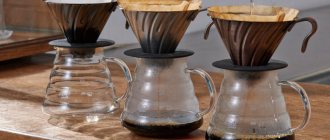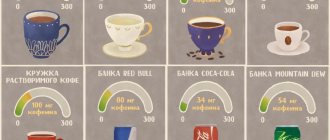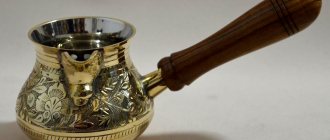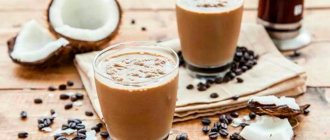Types of coffee
comments 2
Good day, dear readers! Today we’ll talk about what live coffee is. The drink is a real invigorating drink for many people, which allows them to wake up in the morning and get a boost of energy. However, not everyone can boast of truly aromatic coffee, since very often this drink reaches us at the end of its shelf life. This means that all the aroma almost has time to fizzle out and what ends up on the table is not the best version of the drink.
However, now live coffee is produced in Russia, which, due to the reduced transportation time, can retain its taste, color and quality.
For Russia, this drink is new, since many consumers have not seen it on sale before. But in fact, it appeared back in 2005, more than 10 years ago. During this time, the company that produces this product has taken one of the first places in the market.
What is live coffee
It is a natural product obtained by roasting beans and using them within the first month after completing this process. This short period allows the drink to retain all the nutrients and aromatic components, which gives the taster an amazing taste and a pleasant aftertaste.
Raw materials for production are used from the equatorial growing zone of the heat-loving coffee tree. To collect the product, exclusively high-mountain plantations are selected. These areas are also used for growing elite and expensive coffee varieties.
A popular variety is considered to be Arabica, the grains of which grow in Ethiopia. Harvesting continues for eight months and is carried out only by hand. This coffee has excellent taste characteristics and aromatic notes.
The coffee manufacturer truthfully indicates the date of roasting of the beans on the packaging. The benefits and rich taste depend on this period. After the specified period has expired, you can drink coffee, but the living characteristics will already be lost.
How to brew natural Turkish coffee deliciously
Horoscope for every day
1 hour ago
To prepare real coffee manually without a coffee maker or coffee machine, you will need: a Turkish coffee pot, roasted natural coffee beans, clean water.
- Brew coffee correctly using purified tap water; chlorinated water is not suitable for such purposes.
- Raw beans must be roasted before cooking. Roasted coffee beans are not stored for a long time; during long-term storage, almost all the coffee aroma evaporates from the beans.
- You need to grind coffee beans immediately before brewing in order to feel the real aroma of natural freshly ground coffee.
- For brewing in a Turk, fine grinding is used; finely ground coffee rises easier and faster to the neck of the Turk, forming a rich foam. The persistent foam that clogs the neck of the Turka preserves the aroma of brewed coffee.
- There is no need to grind the beans for future use; put enough beans into the coffee grinder to brew 1-2-3 cups of coffee, depending on the size of the coffee grinder.
Razgadamus advises. The type of coffee for many lovers of this popular morning drink does not matter, but everyone who is going to brew their own coffee at home in a saucepan, Turk, or geyser coffee maker should still know the basic instructions. When buying natural coffee, focus on the freshest coffee beans, opt for 100% Arabica - it does not sour and contains less caffeine, unlike the Robusta variety.
Differences from regular coffee
Regular one can be consumed for several years after roasting the beans. However, its taste characteristics are usually unchanged. Conventional varieties are stored for a long period of time under certain conditions and temperatures. Only after many years do the granules completely lose their taste and aroma, and the coffee becomes unsuitable for brewing.
A live drink is a unique type of coffee that guarantees the highest quality from its manufacturer. The value lies in the more tart and rich taste, as well as the strong aroma of the granules or ground material. Which is proven by its unique taste, which is inevitably lost exactly one month after the expiration date.
The difference between live coffee and regular coffee is the period of recommended consumption and the possible yield from one bush. Live varieties are obtained from elite plants, which are harvested 4 times a year, which guarantees the quality of the product.
An innovative solution for pollution removal
—
Where did the idea with the startup, the Green Ocean company, come from?
— My childhood friend Vadim Manov pulled me into this story several years ago. The company is developing, perhaps not as quickly as we would like, but it is an absolutely international business. The company's office is in Holland, the research and development part is in Israel, and the production itself is located in the Baltic states. The company produces high-tech sorbents that absorb oil and industrial oils from any surface. This is an innovative solution in the field of pollution control during emergency or small daily oil spills.
— So you invested in the company and are not developing it?
— Yes, I joined this company as a partner and am a minority shareholder. I am not involved in day-to-day development and operational issues.
— Are you 100 percent owner of the group?
- Yes.
We are faced with the task of emphasizing our peculiarity: “Live Coffee” is a gentle roasting technology that allows you to preserve minerals and vitamins
Advantages and characteristics
Live coffee contains about 120 components, vitamins, and minerals that benefit the human body. From the moment of roasting, the maximum content of unique components in the beans is maintained during the first 6 months. After this period, the value of the grain drink noticeably decreases, as well as the brightness of taste and aroma.
Healthy coffee contains:
- Antioxidants . They help the body fight premature aging and reduce the effects of radiation. These substances effectively fight stress and chronic fatigue. In general, antioxidants support the beauty and healthy appearance of a person.
- Caffeine . Increases a person’s vigor, makes him active and mobile, and adds strength. It affects not only physical, but also mental activity, preventing drowsiness and apathy.
- Minerals and trace elements in the form of phosphates, sulfates, calcium, magnesium, iron and sodium. All these substances support a healthy mind and body.
- B vitamins . They increase the activity of development of biochemical processes, synthesize thyroid hormones, normalize hemoglobin in the blood and lower cholesterol levels.
- Acids . The content of chlorogenic, citric, malic, caffeic, nicotinic and acetic acid is significant. All of them are involved in improving the digestion process, preventing the formation of caries and fighting pathogenic microorganisms.
- Antihistamine components prevent the occurrence of allergic reactions.
Live coffee can cope with severe headaches, improve mood and well-being, and also reduce the harmful effects of nicotine and alcohol on the body.
The group produces live coffee in Russia. The beans are roasted and packaged directly in the country. This technology allows us to deliver fresh product to the consumer in the shortest possible time.
The product line contains several blends of grains that grow in Ethiopia, Colombia, Brazil and other tropical countries.
Positioning
Among competing companies, the company presents itself from the following angles:
- The company's products are positioned as environmentally friendly and healthy.
- “Living Coffee” takes on an educational function, instilling love and knowledge about natural coffee, its varied uses, right down to its brewing methods.
- The company strives to satisfy the tastes of even the most sophisticated consumers, constantly selecting new varieties and methods of roasting coffee beans, creating real live coffee for brewing in a cup.
- Customer feedback is very important for the company, as every positive or negative comment is used to improve products and quality of work.
- The main goal of the company is maximum customer comfort and the highest quality of products.
In grains, not ground
Of course, ground coffee is convenient: you don’t need to waste time on grinding and money on a coffee grinder. However, ground grains have a couple of significant drawbacks that can ruin your drink experience.
Firstly, ground coffee does not live long - yes, vacuum packaging can extend its life, but in an open pack it will age at cosmic speed, and after a few days there will be nothing left of its aroma. Coffee ground 10-12 days ago already has unpleasant, rancid, oxidized flavors in its taste.
Secondly, the grinding may not be suitable for your method of preparation: for Turkish coffee you need a very fine grind, for a French press or drip coffee maker - quite coarse, and if you make espresso at home, there is a high probability that the degree of grinding will have to be changed every day, so For this method of preparation, the size of the coffee particles is especially critical. If you want to prepare the same coffee in different ways, a coffee grinder is a must.
No coffee, no cream - just sugar. Why is the 3-in-1 coffee drink dangerous? More details
How to brew coffee in a Turk (cezve)
Turka has an ancient history behind it. But, despite the invasion of household appliances into our lives, this original vessel does not give up its position. Only in a real copper Turk does coffee turn out rich, with thick foam on the surface.
Traditional method on the stove
Turka is unlike other kitchen utensils. It has a long handle, widens at the bottom, has a narrow waist in the middle, and a comfortable spout at the top. The best Turkish ones are made from copper.
Although the cooking process itself takes about five minutes, you need to arm yourself with some patience. You can’t turn away for a minute, the foam rises very quickly and the drink will instantly run over the edge.
How much coffee do you need?
A generally accepted rule is to put one to two teaspoons of coffee powder per cup. The concentration should not be greatly increased. This will be harmful to health and will spoil the delicate taste and aroma, making the drink overly bitter.
However, in practice, the sizes of coffee cups vary greatly, and everyone has different tastes. Therefore, understanding how much powder to pour usually comes with experience.
Algorithm of actions
Real gourmets follow thousands of different rules and traditions during the cooking process, but first, just follow the general instructions:
- Finely ground coffee is poured into an already warm coffee pot and heated again to release its aroma.
- Pour water, the colder the better.
- Heat the Turka over low heat, carefully monitoring the formation of a creamy foam on the surface.
- When the foam starts to rise and reaches the top edge, the Turk needs to be quickly removed.
- Then bring it to a boil again, remove it, and do the procedure a third time.
To make the grounds settle to the bottom faster, lightly tap the Turk on the table or add a spoonful of cold water to it.
Cooking duration
It is not so much the cooking time that is important, but the correct sequence of actions. The traditional oriental method involves slow cooking over low heat, raising the foam three times. Adding sugar slows down the heating even more, while improving the quality of the foam.
But if you don’t have time before work in the morning, you can pour boiling water over the ground grains. Even if the taste differs from the ideal, it is still much better than instant. One rule must always be followed - coffee should never be boiled.
What types of Turks are there?
Traditionally, Turks are made from copper or cheaper ones from aluminum. Less common are ceramic products with or without coating. Electric variations are also available. Each variety has its own characteristics.
Ceramic
The main feature of such Turks is their thick ceramic walls, which:
- do not absorb odors and do not stain;
- provide uniform heating;
- retain heat well.
You need to remove the ceramic Turk from the heat when the first bubbles appear on the surface. It will give off heat for a long time, and the coffee will rise to the top on its own. If you habitually let the foam rise to the edge, it will definitely run away.
Electric
In essence, an electric Turk is a small electric kettle designed for several cups of ready-made drink. It is compact and easy to use. You just need to pour water and add ground coffee, and the invigorating drink will be ready even faster than on the stove.
Gourmets miss the ability to add personality to an automated cooking process. And yet, this handy device may well come in handy on a trip or at the workplace.
Popular recipes for Turks
If the algorithm for brewing coffee differs slightly, then there are a great many recipes for coffee drinks.
With foam
Thick, dense foam is an indicator of quality. It is formed when essential oils are released from the coffee mass in a mixture with air bubbles. It is fresh, properly processed grains that contain large amounts of oils. The foam preserves the aroma, forming a kind of partition in the narrow neck of the Turka. Spoon it into cups and then carefully pour the coffee.
With milk
The simplest recipe is to add a little milk to a drink prepared according to your favorite recipe. You can also make it entirely with milk instead of water. There are also more sophisticated options. Viennese coffee is topped with a cap of whipped cream, and ice cream is placed in the cold glace.
Dominican
Dominican coffee is distinguished by its high quality. It is added to the blend to improve the taste. Dominican coffee is usually prepared very strong and bitter, similar to espresso. As a rule, geyser coffee makers are used for this. They drink it from small cups, adding a large amount of sugar.
Cinnamon
Of all the spices, cinnamon garnishes coffee best. It not only makes the aroma unique, but also gives vigor and good mood.
Different ways to brew coffee
In order to brew coffee, both ordinary kitchen utensils and modern technical devices are used. The taste of the drink is, of course, different.
In a saucepan
If you don't have anything better at hand, you can brew coffee in a saucepan. You just need to pour water into it and boil it. Then remove the pan from the heat, pour the product itself into it and heat it again. When the grounds float to the top, the drink is ready. Now you need to wait a little until the grounds sink to the bottom, and you can drink the coffee.
In a geyser coffee maker
The coffee in a geyser coffee maker is thick and rich. Cold water is poured into its lower part, and the strainer is filled with coffee powder. The coffee maker is placed on the stove, and steam from boiling water under pressure passes through the ground coffee. At the same time, a seething liquid occurs on the surface, reminiscent of a geyser. The finished drink is collected at the top, from where it can be poured into cups.
In a regular drip coffee maker
Drip coffee makers are the most affordable; thanks to their simple operating principle, everyone understands how to use them. Water is poured into the tank, and the ground grains are poured into a permanent or disposable filter.
All you have to do is press the power button, and the water, passing through the coffee, will drip into the glass jug. The greater the amount of coffee powder, the stronger the drink.
In the coffee machine
The creators of coffee machines managed to completely automate the process. Water and grains are all that the unit requires. The machine itself will grind the beans and prepare espresso in accordance with the specified parameters.
There are also coffee machines designed for ground coffee. The powder is tightly packed into a special horn through which hot water passes. The latest technology is capsule machines, where prepared coffee is sealed in standard capsules.
In the microwave
An indispensable assistant in the kitchen, the microwave oven can also brew coffee. You need to take a larger mug so that the drink does not run away. Place coffee and sugar to taste in it, fill it with water to 2/3 of the volume and put it in the microwave for two minutes at maximum power.
In quartz sand
Residents of southern countries prepare coffee in hot sand. To reproduce this process at home, you need to take a thick frying pan with high walls and pour quartz sand into it.
When the sand warms up well, place a Turk on top of it and dig it in deeper. Then heat until the foam rises. The coffee turns out richer and reveals the aroma better than on the stove.
In the coffee pot
Due to its volume, the coffee pot is well suited for a large company. Coffee is not brewed in it, but brewed. Half the portion is poured with boiling water and the vessel is covered with a lid. You can also plug your nose with something. After 2-3 minutes, add the remaining coffee and water.
The drink will be ready in 5-7 minutes. To improve the result, the coffee pot can be placed in hot water or on a warm surface at this time.










